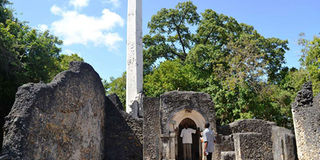Mnarani Ruins: Where baobab, mosques attract tourists

This image taken on April 24, 2019 shows the Great Mosque in Kilifi County. Reconstruction of the mosque was done in the 15th century. PHOTO | KAZUNGU SAMUEL | NATION MEDIA GROUP
What you need to know:
- Mr William Tsaka says the site was first occupied in the early 14th century, but the first place of worship, the Great Mosque, was not built until around AD 1425.
- Mnarani was later destroyed by the Galla, also known as the Oromo, in the early 17th century.
The thick baobab trees, two remnants of mosques and a number of tombs at the Mnarani Ruins in Kilifi are a favourite attraction.
In fact, hundreds of people around the world travel to this site, a place where believers pray and offer sacrifices to God.
The cool breeze blowing from the Indian Ocean and the scenic, peaceful, beautiful garden at Mnarani ruins, a Swahili settlement dating back to 13th century, makes it the perfect place to relax, meditate or pray.
Some of the massive baobab trees here are said to be about 800 years old.
MOSQUE
Mr William Tsaka, the Mnarani Ruins curator, says the site was first occupied in the early 14th century, but the first place of worship, the Great Mosque, was not built until around AD1425.
“Reconstruction of the mosque was done in the 15th century after the collapse of the earlier building,” he said, adding that "hundreds of visitors come to perform rituals and seek spiritual intervention since the tombs, mosque and baobab trees are believed to be holy”.
“The original mosque,” the curator says, “was built around 1475, while the second was put up about 1500. This is evident by the presence of a Portuguese dish in the cistern, an indication that the final alterations to the mosques were probably not completed before the 16th century,” he said.
Mnarani was later destroyed by the Galla, also known as the Oromo, in the early 17th century.
“It’s said that the Wagalla raided the ancient Swahili settlement after learning that the Arabs had captured their men and women and planned to sell them as slaves overseas,” he says.
WAGALLA RAID
Archaeologist James Kirkman, a British resident of Zanzibar in 1950, confirmed this while doing excavation at the mosque, where he found 12 lamps.
“The Wagalla attacked the ancient Swahili settlement, burnt it down and raided their cattle to establish their rule in the region.”
The ruins were gazetted in March 1929. Some scholars see the existence of a slave market at Mitsangoni Koni and Takaungu in Kilifi as evidence that Mnarani ruins, part of the Old Kilifi Town, was attacked for being involved in the slave trade.
At the ruins also lies a dried up 75-foot deep well and remnants of coral reefs and logs arranged in a conical shape. The ancient Swahilis would burn the logs to produce limestone powder for construction.
Interestingly, the inscriptions on the tombs and the mosques here are written in Persian language, suggesting that the early settlers in Mnarani were Persians from Oman.
Only one tomb bears the name of Shaykh Isa Ibn Shayah Nahafah, a written in ancient Arabic.





